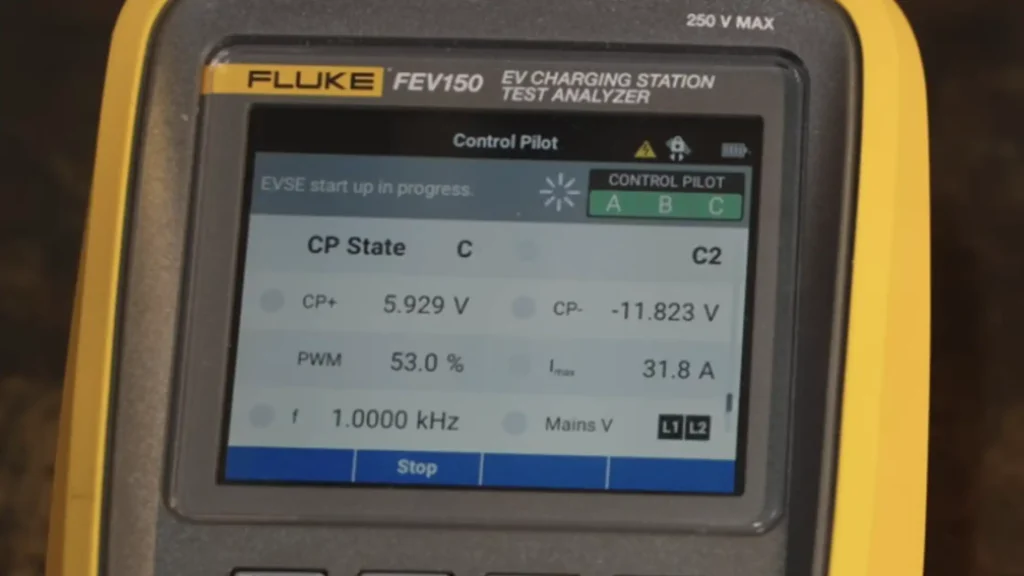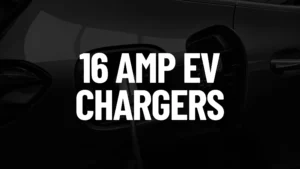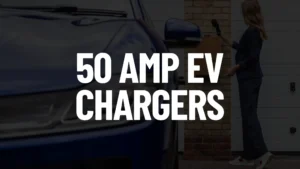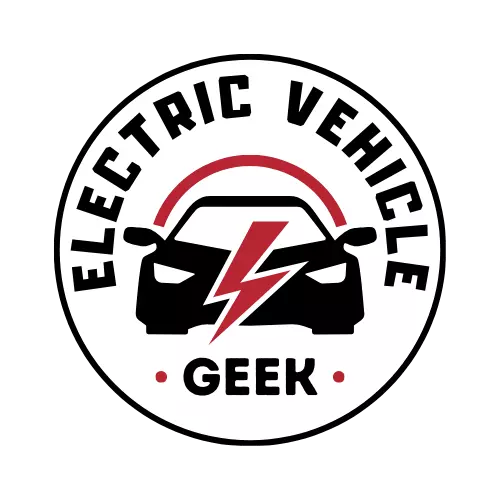Supported by you via insider access, and when you purchase through links on our site, we may earn an affiliate commission. See our Affiliate Disclosure.
Your Guide to EV Charger Amperage
-
 James Ndungu
James Ndungu
- Last Updated October 26, 2025
The EV charger’s amperage (measured in Amps or A) is an EV charger specification that indicates the amount of electrical current an EV charger can supply to your electric vehicle. In simple terms, the higher the amperage, the faster your EV can charge, provided your electric vehicle’s onboard charging system and electrical system can handle it.
Our guide will clearly explain what EV charger amperage means, how it impacts EV charging speed and performance, and what amperage levels are common for different types of EV chargers.
What is an Electric Vehicle Charger Amperage?
An electric vehicle charger’s amperage is the amount of electric current (in amps) it delivers to charge a vehicle’s battery. Combined with voltage (V), which represents electrical pressure, it determines the total power output (kW or kilowatts) of the charger, the key factor that defines how fast an EV can charge.
Power (kW) = (Voltage (V) × Amperage (A)) ÷ 1000
For example, the Tesla Universal Wall Connector is a common Level 2 home charger that operates at 240 volts and 48 amps, providing about 11.5 kilowatts (kW) of power (240 × 48 = 11,520 watts, or 11.5 kW). This power level shows how quickly the charger can recharge a Tesla battery and extend its driving range.
How We Measure EV Charger Amperage
We use the FLUKE FEV150 EV Charger Tester to measure a home EV charger’s maximum charging current (in Amps) and current limit (in Amps). The readings are displayed as Imax, which represents the charger’s highest current rating in amperes (A).
- All-in-one EVSE safety & performance testing
- Excellent TruTest software integration for reporting
- Portable, rugged design with Bluetooth connectivity
- Clear color display with easy pass/fail visuals
- Premium price
- Not intended for residential end-users, designed for technicians
This professional-grade tool does more than measure Electric Vehicle charging amps; it can also simulate different charging states as if an electric vehicle were connected. This lets us observe exactly how the charger performs in real-world conditions.
As a certified installer (Geek) who regularly installs, repairs, tests, and reviews EV chargers, I rely on the FLUKE FEV150 to track dedicated EV charger branch circuit current, voltage, and load behavior during each installation. After wiring the circuit and connecting the charger, we plug in the tester to the charger connector to diagnose voltage drops, confirm current output, and ensure the charger delivers its full rated power. The FLUKE tester displays amperage readings with single-decimal precision (eg, 31.8 A), which we love as experts since small variations in electrical current can impact EV charger specifications, often resulting in slower charging speeds, longer charging times, and reduced efficiency.
As a certified installer (Geek), I regularly install, repair, test, and review EV chargers. I rely on the Fluke FEV150 for accurate troubleshooting and circuit verification across all stages of work. I use it to monitor branch circuit current, voltage, and load behavior during installation, maintenance, and performance testing.
After physically inspecting the EV charger branch circuit wiring and components such as outlets, I connect the charger and plug the tester into the charger’s connector to check for voltage drops, verify current output, and confirm that the unit delivers its full rated power.
The FLUKE EV charger tester displays EV charger amperage readings with single-decimal precision (eg, 31.8 A), which we love as experts since small variations in electrical current can impact EV charger specifications, often resulting in slower charging speeds, longer charging times, and reduced efficiency.

The Fluke EV charger tester has helped us accurately identify several real-world EV charging amperage issues, including overheating outlets and wiring, tripped circuit breakers on dedicated EV charger circuits, incorrect wire sizing, incorrect breaker sizing, and chargers connected to incompatible power sources that cause performance or safety problems.
We recommend using the FLUKE FEV150/TY1 model when testing J1772 chargers, or the FLUKE FEV150/TY1/TSL model when working with both J1772 and NACS chargers. It’s important to note that the FLUKE FEV150 only measures AC chargers and cannot be used for DC fast chargers.
Typical EV Charger Amperage Levels
EV charging is categorized into three main levels, each with a different typical amperage and voltage:
Level 1 EV Charger Amps
A Level 1 EV charger uses a 120-volt AC outlet and typically draws 12 to 16 amps, delivering 1.4 to 1.9 kilowatts (kW) of charging power. This amperage adds about 2 to 5 miles of range per hour, making it the slowest but most accessible home charging option.
Home (standard wall outlet)
Level 2 EV Charger Amps
A Level 2 EV charger operates on a 240-volt AC circuit and typically delivers 16 to 80 amps, depending on the model and electrical setup. This provides 3.8 to 19.2 kilowatts (kW) of power, adding about 10 to 75 miles of range per hour.
Home (dedicated circuit), Public
Level 3 EV Charger Amps
A Level 3, or DC fast charger, uses direct current (DC) and can deliver anywhere from 100 to over 500 amps at high voltages (typically 400V to 1000V). This allows power output from 50 kW to 360 kW or more, adding up to 180–240 miles of range per hour.
Public (highway corridors, commercial)
Level 2 EV Charger Amps Breakdown
Level 2 chargers are the standard for fast residential and public AC charging. Common Level 2 EV charger amperage options include:
12A, 120/240V (1.44 kW)
12A EV charger adds 3–8 miles/hour, convenient Level 1 home charging for smaller EVs.
16A, 120/240V (1.92–3.84 kW)
16A EV charger adds 3–12 miles/hour, faster Level 1 or entry-level Level 2 home charging.
24A, 240V (5.76 kW)
24A EV charger adds 22 miles/hour, reliable Level 2 home charging for everyday use.
32A, 240V (7.68 kW)
32A EV charger adds 26 miles/hour, consistent Level 2 home charging for most residential EVs
40A, 240V (9.6 kW)
40A EV charger adds 30 miles/hour, ideal Level 2 home charging for larger EV batteries.
48A, 240V (11.5 kW)
48A EV charger adds 40 miles/hour, efficient Level 2 home charging for high-capacity EVs.
50A, 240V (12 kW)
50A EV charger adds 45 miles/hour, fast and reliable Level 2 home charging at home.
80A, 240V (19.2 kW)
80A EV charger adds 75 miles/hour, rapid Level 2 home charging for long-range EVs.
Choosing the Right EV Charger Amperage
Choosing the right EV charger amperage helps make charging efficient, safe, and suitable for both your EV’s onboard charger (OBC) and your home’s electrical setup. Home EV chargers come in a wide range, from 12–16 amps for basic Level 1 chargers to 16–80 amps for faster Level 2 models, allowing you to choose the best fit for your charging speed and power needs.
When selecting an EV charger, always consider:
EV's Maximum AC Acceptance
Check your vehicle’s specifications to see the maximum AC power (kW) or amperage (A) it can accept. There’s no benefit to installing a 48A charger if your car’s onboard charger can only take 32A
Your Daily Driving Needs
If you drive minimal miles, a lower amperage charger might be enough. If you frequently deplete your battery, higher amperage is essential for a complete overnight charge.
Home Electrical Capacity
A higher-amperage charger requires a larger, dedicated circuit and potentially an upgrade to your home’s main electrical panel, which can significantly increase installation costs.
Editor Tip: To get the fastest charging speed, choose a charger with an amperage rating that matches or slightly exceeds your EV’s onboard charger capacity, as long as your home’s electrical panel can safely handle the required circuit breaker.
Why Do Amps Matter in EV Charging?
When selecting or installing an EV charger, it’s crucial to understand both the charger’s amperage and your electrical system’s capacity to support it. This ensures safety, efficiency, and compliance with electrical codes.
As the amperage increases, the wire gauge must have sufficient ampacity to safely handle the higher current. For example, a 32‑amp Level 2 EV charger typically requires at least 8 AWG copper wire, while a 48‑amp charger may need 6 AWG copper wire.
As the charging current increases, the circuit breaker must be rated to handle the continuous load safely. For instance, a 32-amp Level 2 EV charger typically requires a 40-amp breaker, while a 48-amp charger is paired with a 60-amp breaker.
Voltage drop occurs when the voltage at the end of a cable is lower than at the start, increasing with longer cable runs. To reduce voltage drop, use a larger wire. For a 48A EV charger 120ft from the panel, 4AWG copper may be needed for safe and efficient charging.
Higher Voltage Decreases Amps
For the same power, increasing the voltage reduces the current needed. For example, a 1.44 kW charger draws 12 amps at 120 V (Level 1) but only 6 amps at 240 V (Level 2). This is why higher-voltage Level 2 chargers can deliver power more efficiently with smaller wires.
Expert Tip: If you’re on a budget and not ready to upgrade your home’s wiring or breaker, get an adjustable amperage EV charger. It safely matches your circuit’s capacity, maximizing energy efficiency and preventing overloads and tripped breakers. Some smart chargers, such as the Autel MaxiCharger 80A EV charger, use Dynamic Load Balancing (DLB) to automatically adjust charging power based on your home’s energy use. Later, you can increase the amperage if you upgrade your electrical panel; no need to buy a new charger.

James Ndungu is a certified EV charger installer with over five years of experience in EVSE selection, permitting, and installation. He holds advanced credentials, including certification from the Electric Vehicle Infrastructure Training Program (EVITP) and specialized training in EV charging equipment and installation, as well as diplomas in EV Technology and Engineering Fundamentals of EVs. Since 2021, James has tested dozens of EV chargers and accessories, sharing expert insights into the latest EV charging technologies.










